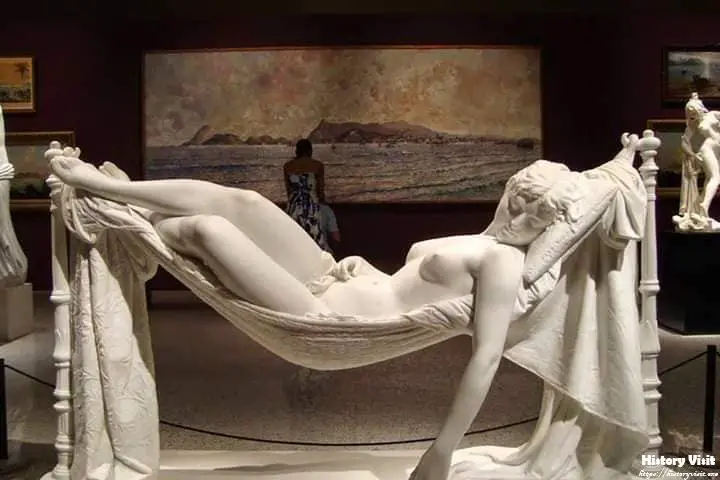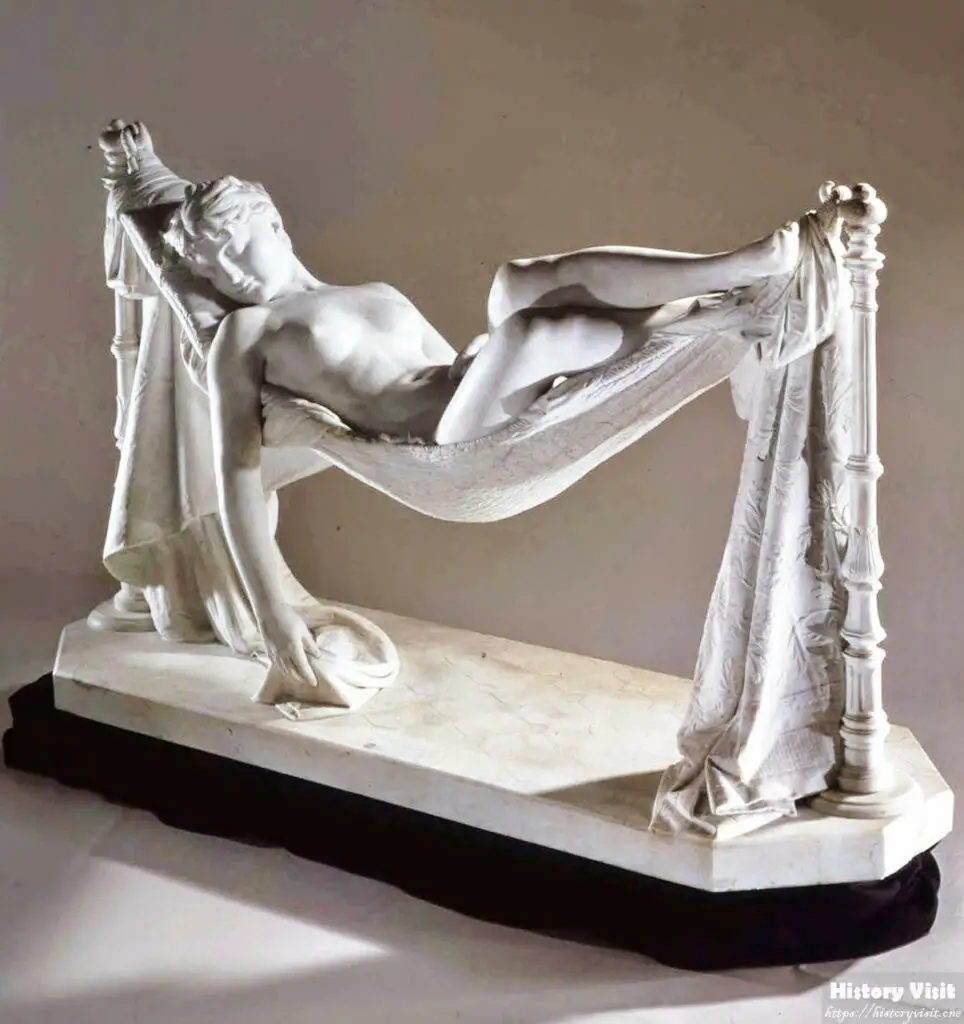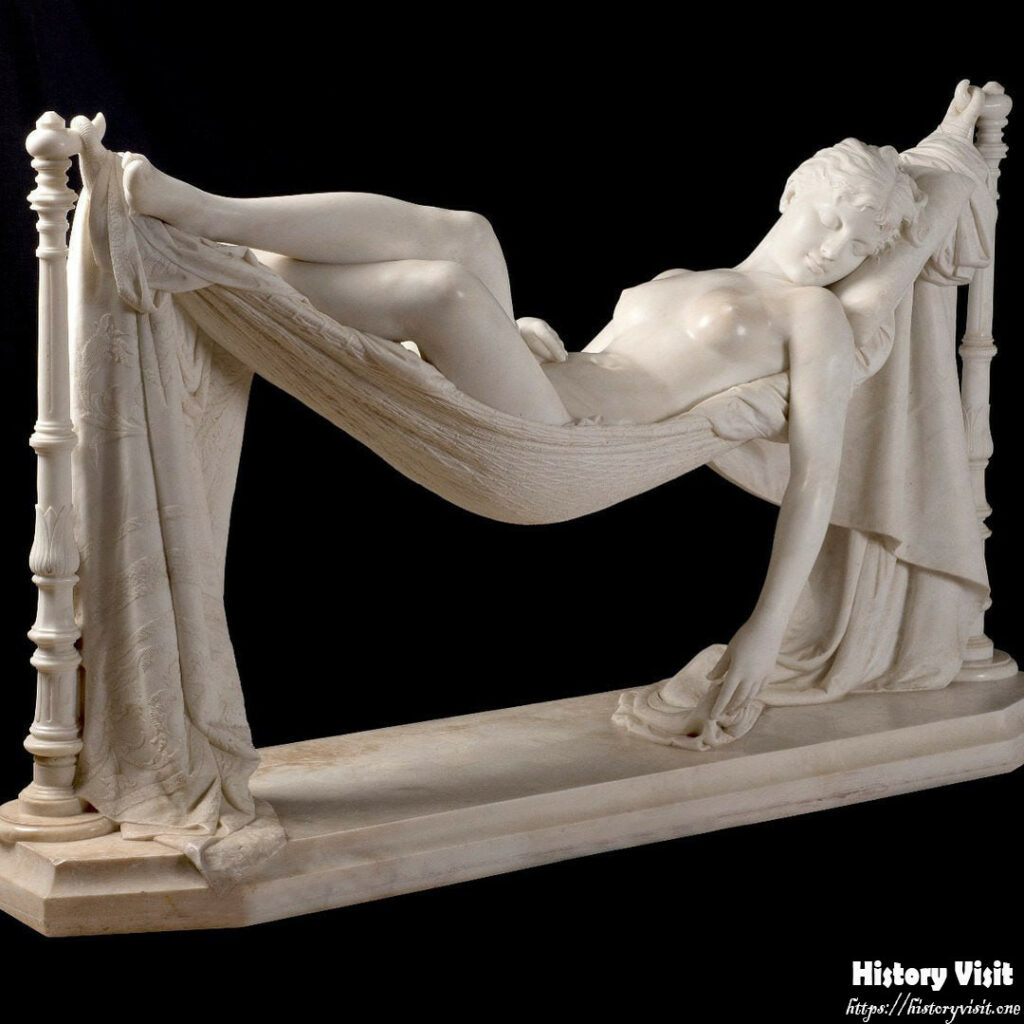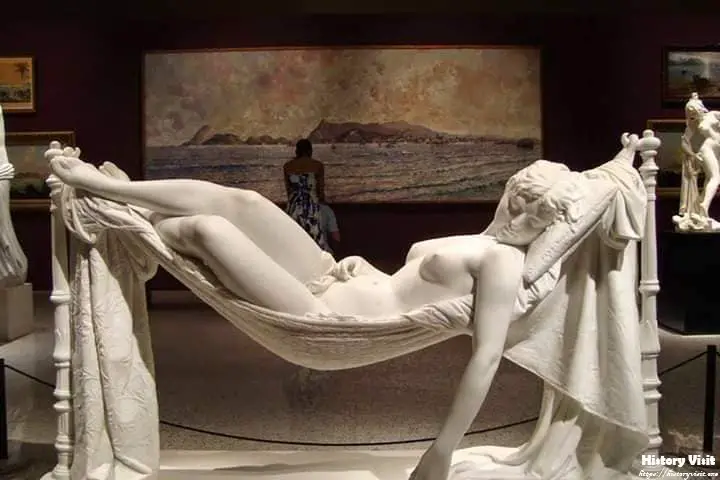Sweet Dreams (1892): Sculptor Antonio Frilli

Introduction
Antonio Frilli, an eminent Italian sculptor of the late 19th century, is celebrated for his exquisite marble creations that captured the imagination of his contemporaries and continue to enchant art lovers today. Among his many notable works, “Sweet Dreams” (1892) stands out as a masterpiece of delicate beauty and technical skill. This sculpture not only exemplifies Frilli’s artistic prowess but also embodies the aesthetic and cultural values of its time.
“Sweet Dreams” is a testament to Frilli’s ability to infuse marble with a lifelike softness and grace, making the viewer almost believe in the tangible reality of his creations. As we delve into the details of this work, it becomes clear that Frilli was not just a master craftsman but also a sensitive interpreter of human emotion and form. His work reflects a deep understanding of both the physical and psychological aspects of his subjects.
Understanding “Sweet Dreams” requires a comprehensive exploration of its historical context, artistic features, and Frilli’s broader body of work. This article aims to provide such an exploration, highlighting the significance of this piece within the broader framework of 19th-century sculpture and Frilli’s enduring legacy in the art world.
Historical Context

The year 1892 was a period rich with artistic innovation and cultural dynamism. The late 19th century saw the waning influence of the Romantic era and the rise of new artistic movements that sought to break away from classical traditions. Artists were increasingly exploring realism, impressionism, and symbolism, each bringing fresh perspectives and techniques to the fore. In this vibrant milieu, sculpture played a critical role in pushing the boundaries of aesthetic expression.
Antonio Frilli emerged as a prominent figure in this transformative period, bringing a distinct Italian flavor to his sculptures. Italy, with its rich Renaissance heritage, continued to influence and inspire artists who sought to balance classical beauty with modern sensibilities. Frilli’s work, including “Sweet Dreams,” is deeply rooted in this tradition, yet it also reflects the subtle shifts towards more personal and emotive forms of expression.
The cultural climate of 1892, marked by industrial progress and social changes, also influenced the themes and styles in art. As artists like Frilli navigated these changes, they produced works that resonated with contemporary audiences while also adhering to timeless principles of beauty and form. “Sweet Dreams” is a product of this unique intersection of historical continuity and artistic innovation.
Description of “Sweet Dreams”

“Sweet Dreams” is a striking sculpture that captures a serene moment of repose. The piece depicts a young girl lying on her side, seemingly lost in a peaceful slumber. Her delicate features are rendered with remarkable finesse, highlighting Frilli’s mastery in portraying human anatomy with lifelike precision. The softness of her expression and the gentle curve of her body convey a sense of tranquility and innocence.
Crafted from marble, the sculpture showcases Frilli’s ability to manipulate the medium to achieve a lifelike softness. The folds of the girl’s dress and the subtle play of light and shadow on her skin demonstrate his technical prowess. Frilli’s attention to detail extends to the smallest elements, such as the texture of the fabric and the delicate curls of the girl’s hair, each meticulously carved to enhance the overall realism.
The composition of “Sweet Dreams” is equally noteworthy. The horizontal alignment of the figure and the harmonious balance of forms create a pleasing visual rhythm. The positioning of the girl, with one arm resting gently on her side and the other under her head, reinforces the theme of restful sleep. This careful arrangement not only adds to the aesthetic appeal but also deepens the emotional impact of the sculpture.
Artistic Analysis
“Sweet Dreams” invites viewers into a moment of quiet introspection and emotional connection. The sculpture’s theme revolves around the innocence and purity of childhood, captured through the serene expression of the sleeping girl. This depiction of peaceful sleep resonates with universal sentiments of comfort and safety, making the piece profoundly relatable.
Frilli’s use of form, texture, and space in “Sweet Dreams” enhances its expressive quality. The smooth, polished surface of the marble mimics the softness of skin, while the detailed rendering of the girl’s dress and hair adds a tactile richness. The interplay of light and shadow across the sculpture’s surface creates depth and dimension, drawing the viewer’s eye and emphasizing the contours of the figure.

The emotional and psychological impact of “Sweet Dreams” lies in its ability to evoke a sense of calm and nostalgia. The viewer is drawn into a contemplative state, reflecting on the simplicity and innocence of childhood. This emotional engagement is a testament to Frilli’s skill in not only capturing physical likeness but also in conveying deeper, intangible qualities through his art.
Frilli’s Artistic Style
Antonio Frilli’s work is characterized by a refined elegance and meticulous attention to detail. His sculptures often embody a classical beauty, rooted in the traditions of the Renaissance, yet they also possess a modern sensitivity to emotional expression. “Sweet Dreams” is a prime example of this blend, showcasing Frilli’s ability to balance aesthetic perfection with a heartfelt narrative.
A comparison of “Sweet Dreams” with Frilli’s other works reveals consistent themes and techniques. Frilli frequently depicted young women and children, capturing moments of innocence and grace. His use of marble, a material synonymous with classical sculpture, allowed him to achieve a high level of detail and polish, enhancing the lifelike quality of his figures. This technical skill, combined with his emotive subject matter, set Frilli apart from many of his contemporaries.
Frilli’s Italian heritage is evident in his work, drawing from the rich artistic legacy of his homeland. The influence of Renaissance masters is clear in his adherence to proportion, beauty, and harmony. Yet, Frilli also infused his sculptures with a sense of individuality and emotion, reflecting the changing tastes and sensibilities of the late 19th century. This unique combination of classical and contemporary elements defines his artistic style and enduring appeal.
Reception and Legacy
Upon its unveiling, “Sweet Dreams” received considerable acclaim for its exquisite craftsmanship and emotive power. Contemporary critics praised Frilli’s ability to breathe life into marble, creating a sculpture that was both visually stunning and deeply moving. The piece resonated with audiences, who appreciated its beauty and the tender sentiment it conveyed.

The influence of “Sweet Dreams” extended beyond its immediate reception. Frilli’s work inspired a generation of sculptors who admired his technical mastery and his ability to capture the human condition. The themes of innocence and tranquility in “Sweet Dreams” found echoes in the works of other artists, contributing to a broader appreciation of emotional depth in sculpture.
Today, “Sweet Dreams” remains a significant piece in the study of 19th-century sculpture. It is often featured in exhibitions and collections, continuing to captivate viewers with its timeless beauty. Frilli’s legacy endures not only through his sculptures but also through the lasting impact he had on the art world, bridging the gap between classical traditions and modern expressions.
Conclusion

“Sweet Dreams” by Antonio Frilli is more than just a sculpture; it is a window into the artistic and cultural milieu of the late 19th century. Frilli’s masterful technique and emotive storytelling combine to create a piece that is both aesthetically pleasing and profoundly moving. The sculpture captures a moment of pure tranquility, inviting viewers to reflect on the simple, yet profound, beauty of innocence and repose.
Frilli’s contribution to the art world extends beyond his individual works. His ability to infuse marble with life and emotion set a high standard for sculptors who followed. “Sweet Dreams” exemplifies his skill and vision, showcasing the harmonious blend of classical beauty and modern sensitivity that defines his oeuvre.
As we continue to appreciate and study “Sweet Dreams,” we gain deeper insights into the artistic innovations and cultural values of Frilli’s time. The sculpture remains a testament to the enduring power of art to transcend time and touch the human soul, ensuring that Frilli’s legacy will be cherished for generations to come.


